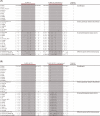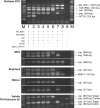A novel multiplex PCR discriminates Bacillus anthracis and its genetically related strains from other Bacillus cereus group species
- PMID: 25774512
- PMCID: PMC4361551
- DOI: 10.1371/journal.pone.0122004
A novel multiplex PCR discriminates Bacillus anthracis and its genetically related strains from other Bacillus cereus group species
Abstract
Anthrax is an important zoonotic disease worldwide that is caused by Bacillus anthracis, a spore-forming pathogenic bacterium. A rapid and sensitive method to detect B. anthracis is important for anthrax risk management and control in animal cases to address public health issues. However, it has recently become difficult to identify B. anthracis by using previously reported molecular-based methods because of the emergence of B. cereus, which causes severe extra-intestinal infection, as well as the human pathogenic B. thuringiensis, both of which are genetically related to B. anthracis. The close genetic relation of chromosomal backgrounds has led to complexity of molecular-based diagnosis. In this study, we established a B. anthracis multiplex PCR that can screen for the presence of B. anthracis virulent plasmids and differentiate B. anthracis and its genetically related strains from other B. cereus group species. Six sets of primers targeting a chromosome of B. anthracis and B. anthracis-like strains, two virulent plasmids, pXO1 and pXO2, a bacterial gene, 16S rRNA gene, and a mammalian gene, actin-beta gene, were designed. The multiplex PCR detected approximately 3.0 CFU of B. anthracis DNA per PCR reaction and was sensitive to B. anthracis. The internal control primers also detected all bacterial and mammalian DNAs examined, indicating the practical applicability of this assay as it enables monitoring of appropriate amplification. The assay was also applied for detection of clinical strains genetically related to B. anthracis, which were B. cereus strains isolated from outbreaks of hospital infections in Japan, and field strains isolated in Zambia, and the assay differentiated B. anthracis and its genetically related strains from other B. cereus group strains. Taken together, the results indicate that the newly developed multiplex PCR is a sensitive and practical method for detecting B. anthracis.
Conflict of interest statement
Figures




Similar articles
-
Rapid genotypic detection of Bacillus anthracis and the Bacillus cereus group by multiplex real-time PCR melting curve analysis.FEMS Immunol Med Microbiol. 2005 Feb 1;43(2):301-10. doi: 10.1016/j.femsim.2004.10.005. FEMS Immunol Med Microbiol. 2005. PMID: 15681162
-
Strategy for identification of Bacillus cereus and Bacillus thuringiensis strains closely related to Bacillus anthracis.Appl Environ Microbiol. 2006 Feb;72(2):1295-301. doi: 10.1128/AEM.72.2.1295-1301.2006. Appl Environ Microbiol. 2006. PMID: 16461679 Free PMC article.
-
A multiplex real-time PCR for identifying and differentiating B. anthracis virulent types.Int J Food Microbiol. 2011 Mar 1;145 Suppl 1:S137-44. doi: 10.1016/j.ijfoodmicro.2010.07.039. Epub 2010 Aug 10. Int J Food Microbiol. 2011. PMID: 20826037
-
What sets Bacillus anthracis apart from other Bacillus species?Annu Rev Microbiol. 2009;63:451-76. doi: 10.1146/annurev.micro.091208.073255. Annu Rev Microbiol. 2009. PMID: 19514852 Review.
-
Biology and taxonomy of Bacillus cereus, Bacillus anthracis, and Bacillus thuringiensis.Can J Microbiol. 2007 Jun;53(6):673-87. doi: 10.1139/W07-029. Can J Microbiol. 2007. PMID: 17668027 Review.
Cited by
-
Feral Swine as Indirect Indicators of Environmental Anthrax Contamination and Potential Mechanical Vectors of Infectious Spores.Pathogens. 2023 Apr 20;12(4):622. doi: 10.3390/pathogens12040622. Pathogens. 2023. PMID: 37111508 Free PMC article.
-
Ba813 harboring Bacillus cereus, genetically closely related to Bacillus anthracis, causing nosocomial bloodstream infection: Bacterial virulence factors and clinical outcome.PLoS One. 2020 Jul 13;15(7):e0235771. doi: 10.1371/journal.pone.0235771. eCollection 2020. PLoS One. 2020. PMID: 32658912 Free PMC article.
-
A classification framework for Bacillus anthracis defined by global genomic structure.Evol Appl. 2020 Jan 23;13(5):935-944. doi: 10.1111/eva.12911. eCollection 2020 May. Evol Appl. 2020. PMID: 32431744 Free PMC article.
-
Prevalence, Toxin Genes, and Antibiotic Resistance Profiles of Bacillus cereus Isolates from Spices in Antalya and Isparta Provinces in Türkiye.Indian J Microbiol. 2023 Dec;63(4):549-561. doi: 10.1007/s12088-023-01111-7. Epub 2023 Oct 31. Indian J Microbiol. 2023. PMID: 38031610 Free PMC article.
-
Development of a PCR-dipstick DNA chromatography-based tool for the detection of CTX-M- and TEM-producing Escherichia coli and Klebsiella pneumoniae isolated from patients in Kafue and Katete districts of Zambia.BMC Infect Dis. 2025 Apr 16;25(1):541. doi: 10.1186/s12879-025-10628-9. BMC Infect Dis. 2025. PMID: 40240940 Free PMC article.
References
-
- World Health Organization. Guidelines for the Surveillance and Control of Anthrax in Human and Animals. 3rd ed Geneva: WHO Press; 1998.
-
- Mock M, Fouet A. Anthrax. Annu Rev Microbiol. 2001;55: 647–671. - PubMed
-
- Dixon TC, Meselson M, Guillemin J, Hanna PC. Anthrax. N Engl J Med. 1999;341: 815–826. - PubMed
Publication types
MeSH terms
Substances
LinkOut - more resources
Full Text Sources
Other Literature Sources
Molecular Biology Databases
Research Materials

